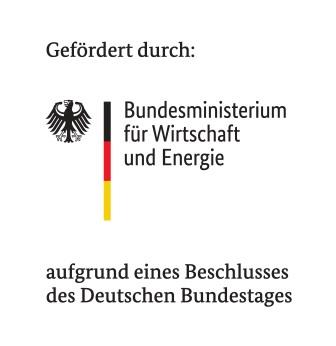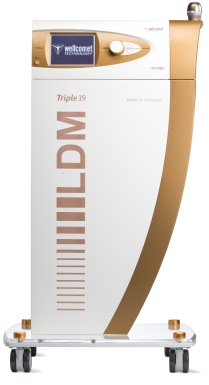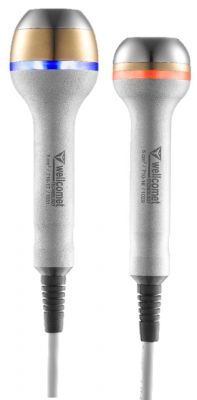LDM Triple®
the device with triple-success technology
The LDM Triple® device differs significantly from conventional ultrasound devices by its world-wide unique triple-ultrasound wave (triple LDM®) and is used in aesthetic medicine and dermatology. It can be used all year round and can be easily combined with a variety of existing treatment methods on the market.
The special ultrasound waves of the LDM Triple® can also be used as a supportive treatment at wrinkle injections and as a pre- and postoperative measure in aesthetic plastic surgery. The ultrasound technologies used in this device, such as the 10 or 19 MHz, LDM® and the triple LDM® technology, can intensify and visibly improve the treatment results of your customers.
Once tested, your customers will be amazed by the innovative triple LDM® effect!
Application:
Aesthetic treatments
- Wrinkles/folds
- Anti-Aging
- Skin Tightening)
- Skin rejuvenation
- Phonophoresis (face/body)
- Strech marks/Cellulite
- Pre- and Post tratments by aesthetic surgery
Dermatological treatments
- Acne
- Acne scars
- Atopic/perioral dermatitis
- Ekzema
- Hyperthrophic scars / Keloids
- Ulcus cruris
WHAT MAKES THE LDM Triple® TECHNOLOGIES SUCH VERSATILE AND UNIQUE?
While most ultrasound systems only frequencies in the range 1 to max. 5 MHz, and the introduced energy is thus mainly concentrated far below the dermis, the LDM Triple device additionally uses ultrasonic waves with a special frequency of 10 MHz and 19 MHz.
With a half-depth of just about 3 mm / 1.5 mm, these two frequencies work mainly in the upper layers of the skin. With the 19 MHz requency, even more superficial work is possible, especially in the dermis and the border of the dermis / subcutis.
Because these special frequencies have additionally a very small wavelength of 150 μm/ 75 μm, they can directly influence single cells or small cell groups within tissue and so be responsible for some specific cell reactions that differ qualitatively from the reactions on conventional ultrasound waves.
What means triple LDM®?
Triple LDM® is a further development of the LDM® technology and, similar to the LDM® technology, involves an instantaneous change between different frequencies. However, as an innovation in the esthetics and medical market, this particular technology clearly stands out from other ultrasound systems by changing three frequencies simultaneously.
The use of three different frequencies allows an even greater dynamic pressure distribution in the tissue over several layers and may additionally lead to a differentiated physiological effect. In addition to the combination wave 1/3/10 MHz, the LDM Triple works with the setting 3/10/19 MHz and integrates for the first time the innovative 19 MHz frequency in the triple technology.
Which effect does LDM® have on skin?
The ultrasonic waves used in the LDM Triple as well as their LDM® and triple LDM® combinations can modulate individual tissue
structures and thus specifically intervene into dynamic processes of the connective tissue. For example, they do not only regulate
the so-called matrix metalloproteinases (MMPs), that are primarily responsible for tissue degradation, but also influence the
production of so-called heat shock proteins (HSPs), that are necessary for proper protein control in tissue. Hyaluronic acid (HA)
levels in the skin can also be specifically influenced with certain ultrasound frequencies that in turn can lead to more turgor and
some rapidly visible structural changes in tissue.
What is the treatment schedule of LDM Triple?
Improvement of the skin appearance by the reduction of skin pores and smoothing of the skin microrelief can often be observed directly after the first treatment. These effects have already been successfully demonstrated in a multicenter study. Depending on the age and condition of the skin, treatment cures with 2 sessions per week over a period of 4-6 weeks are recommended. For dermatological indications usually 6-8 treatments are needed and in complicated cases 10-16 treatments. The specific number of treatments depends on the clinical picture and the course of the patient.




